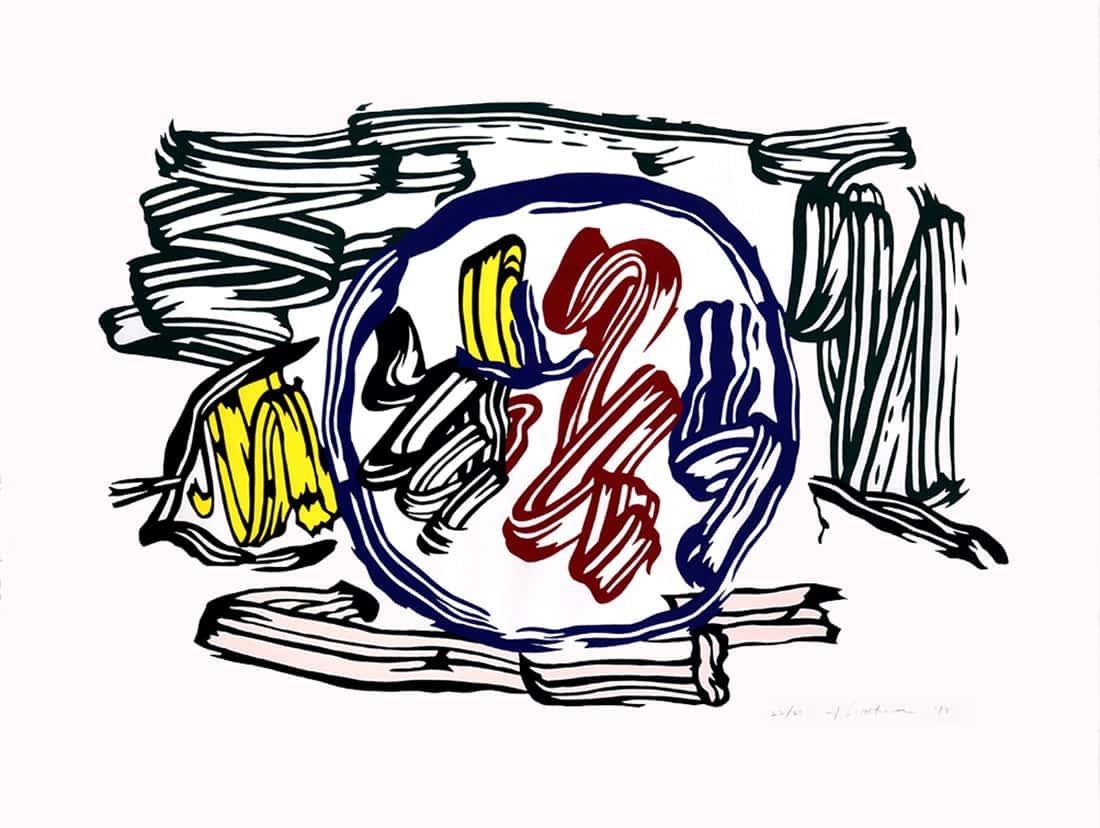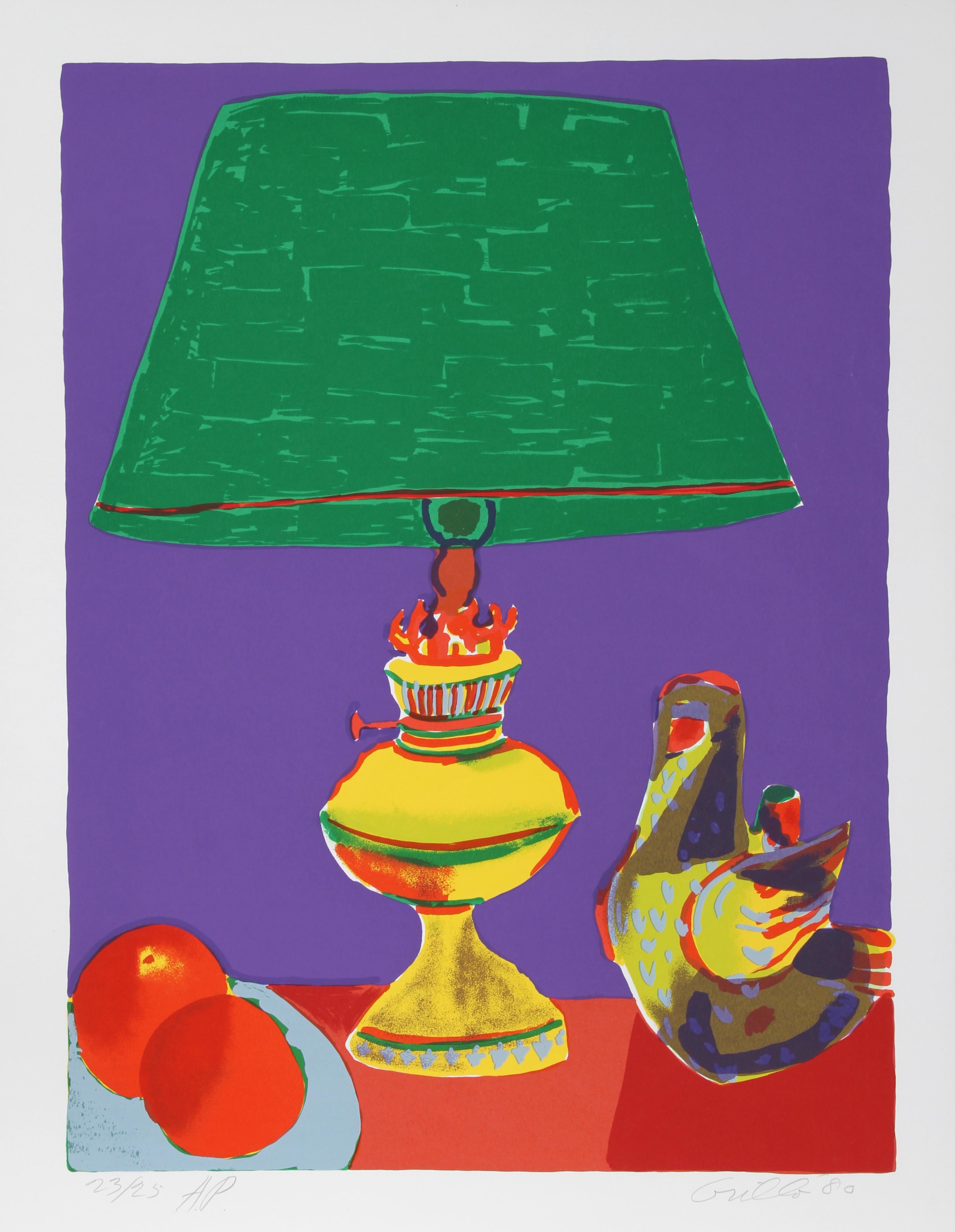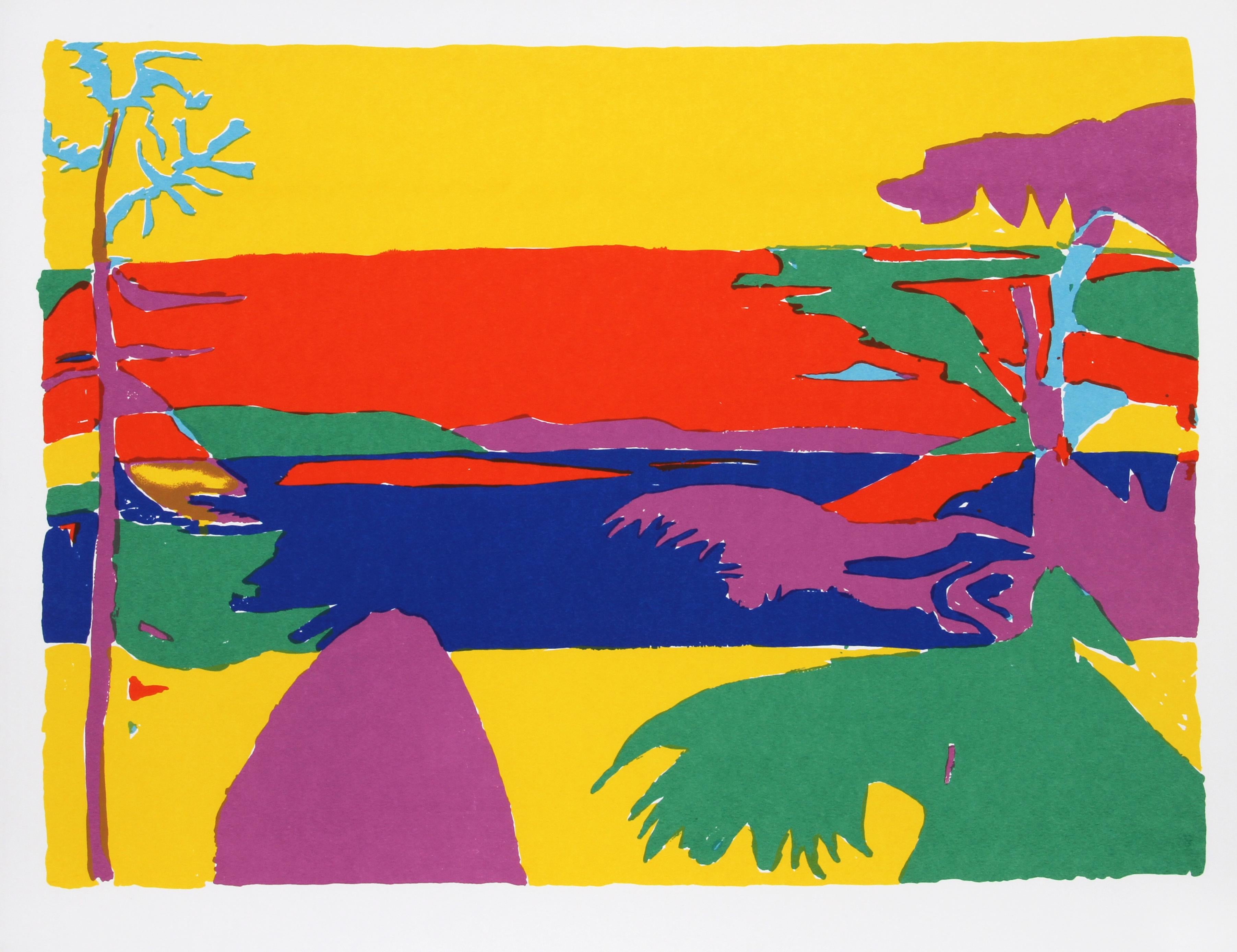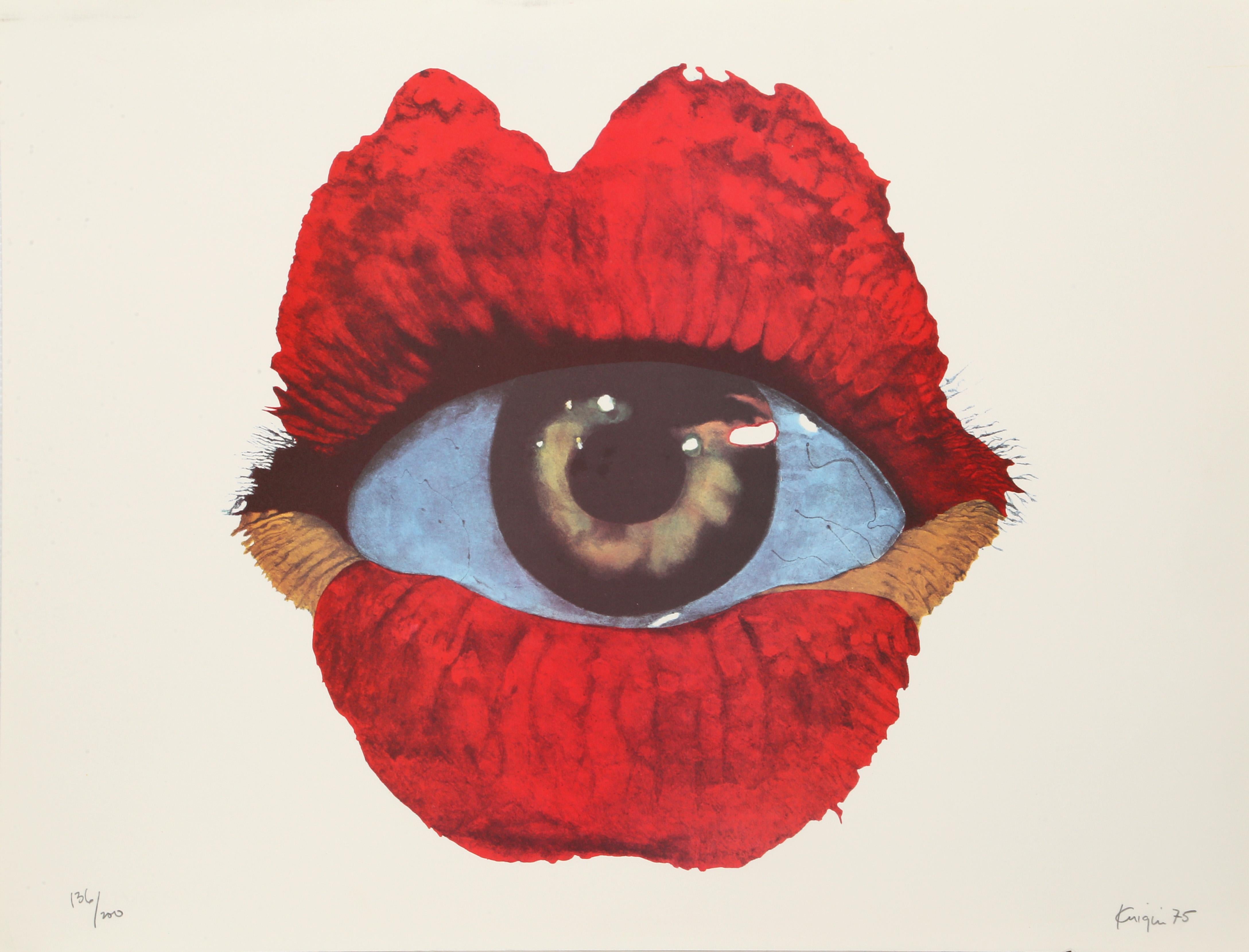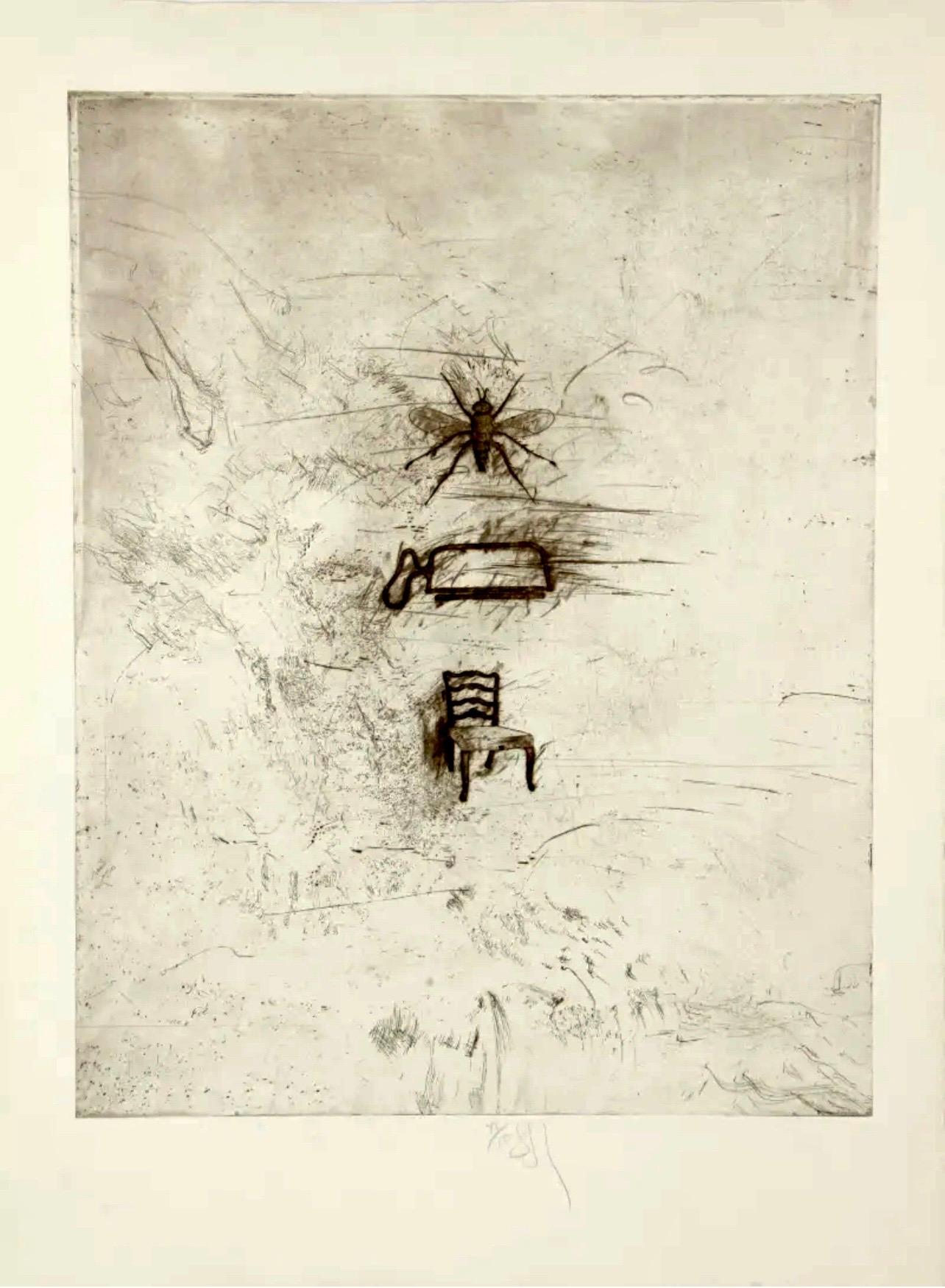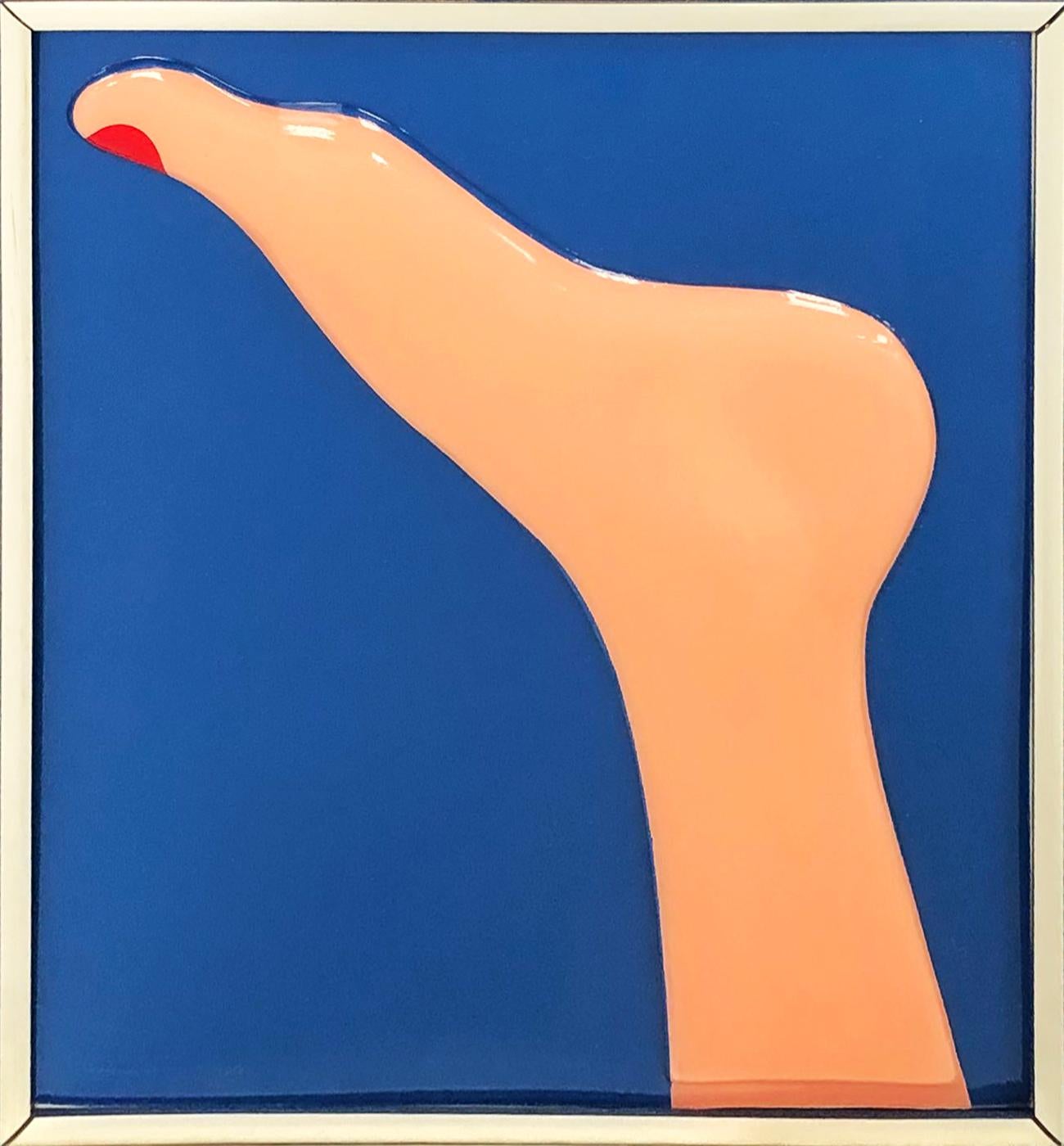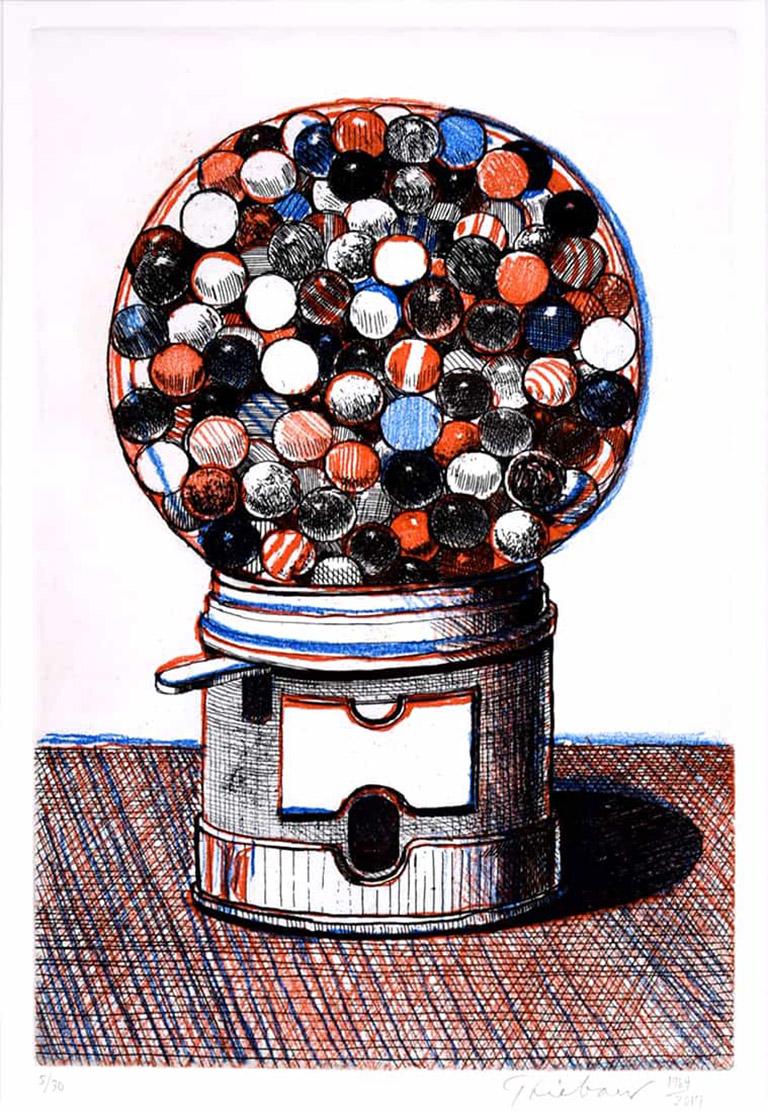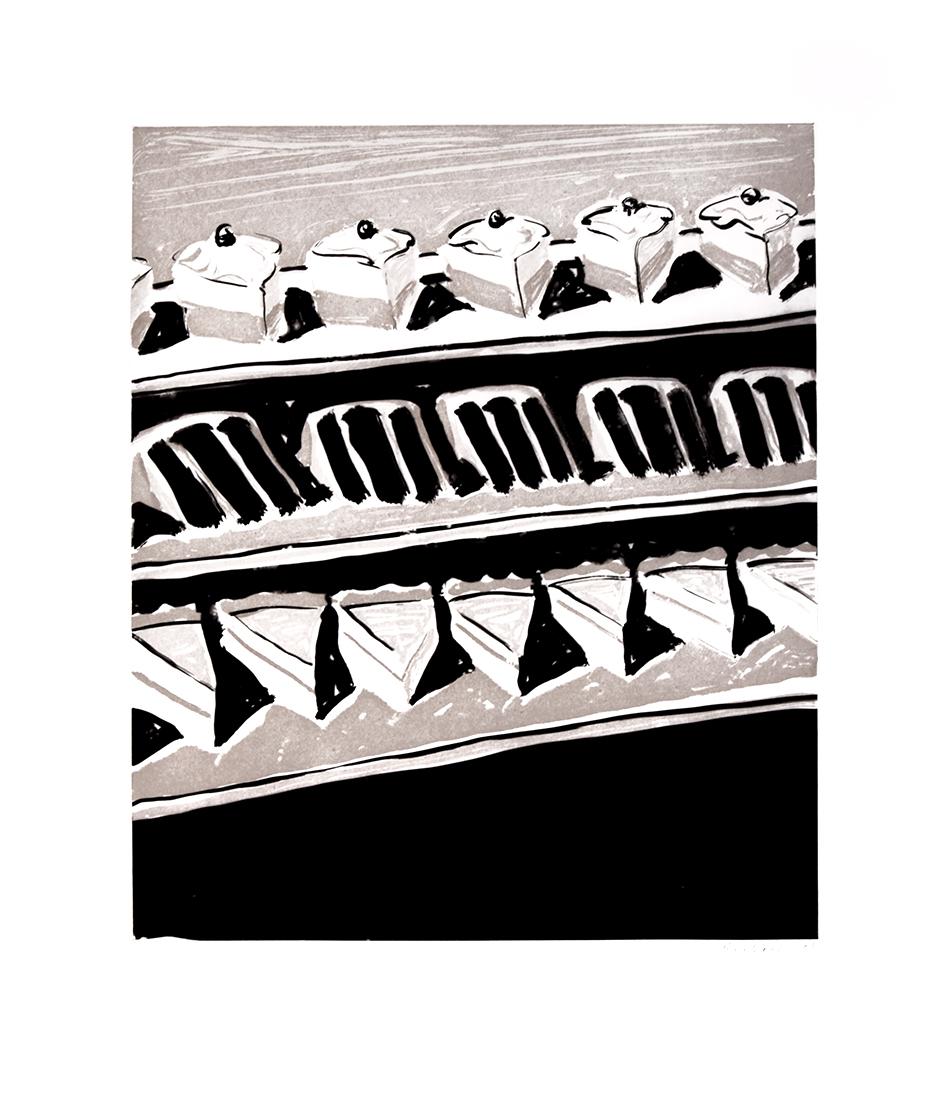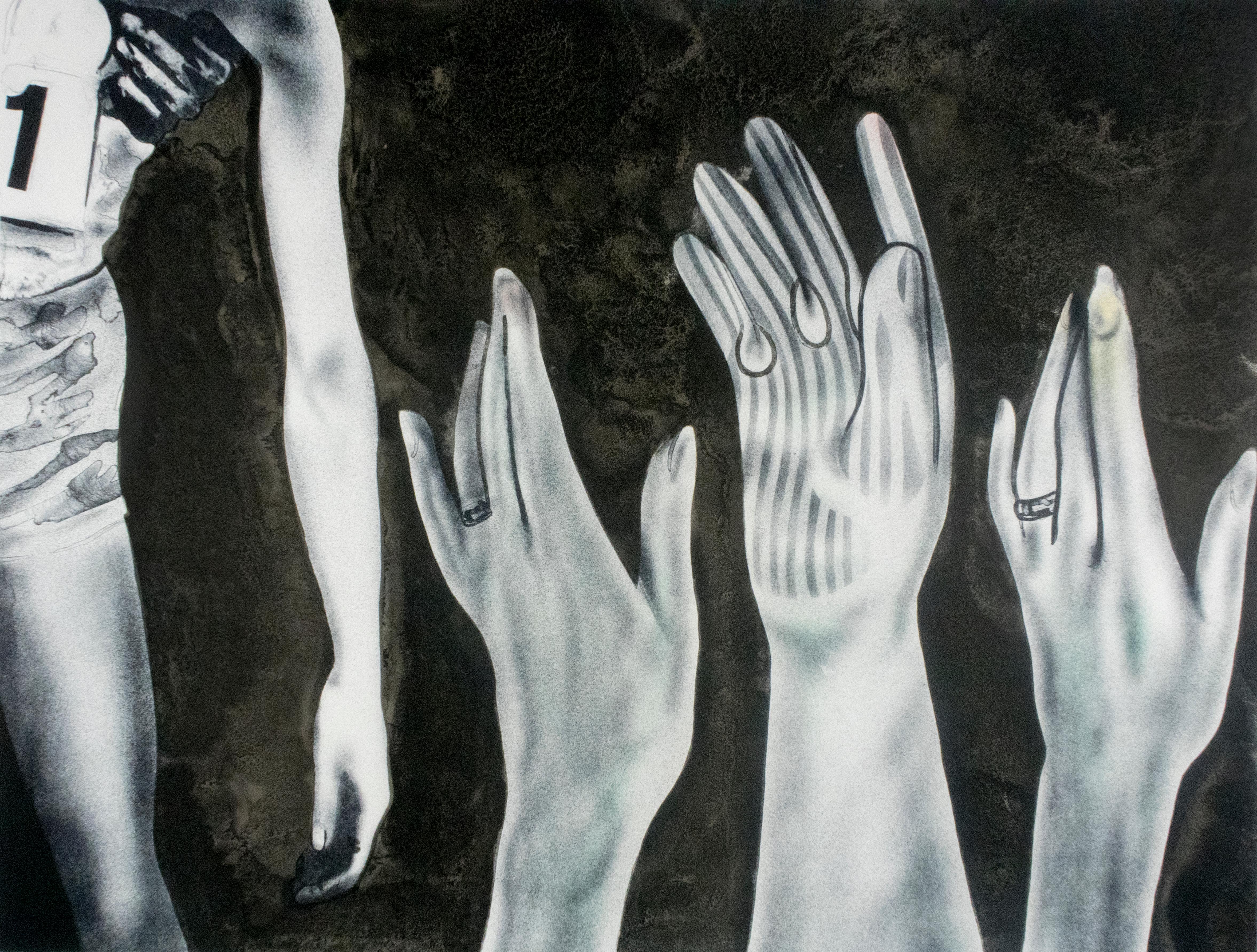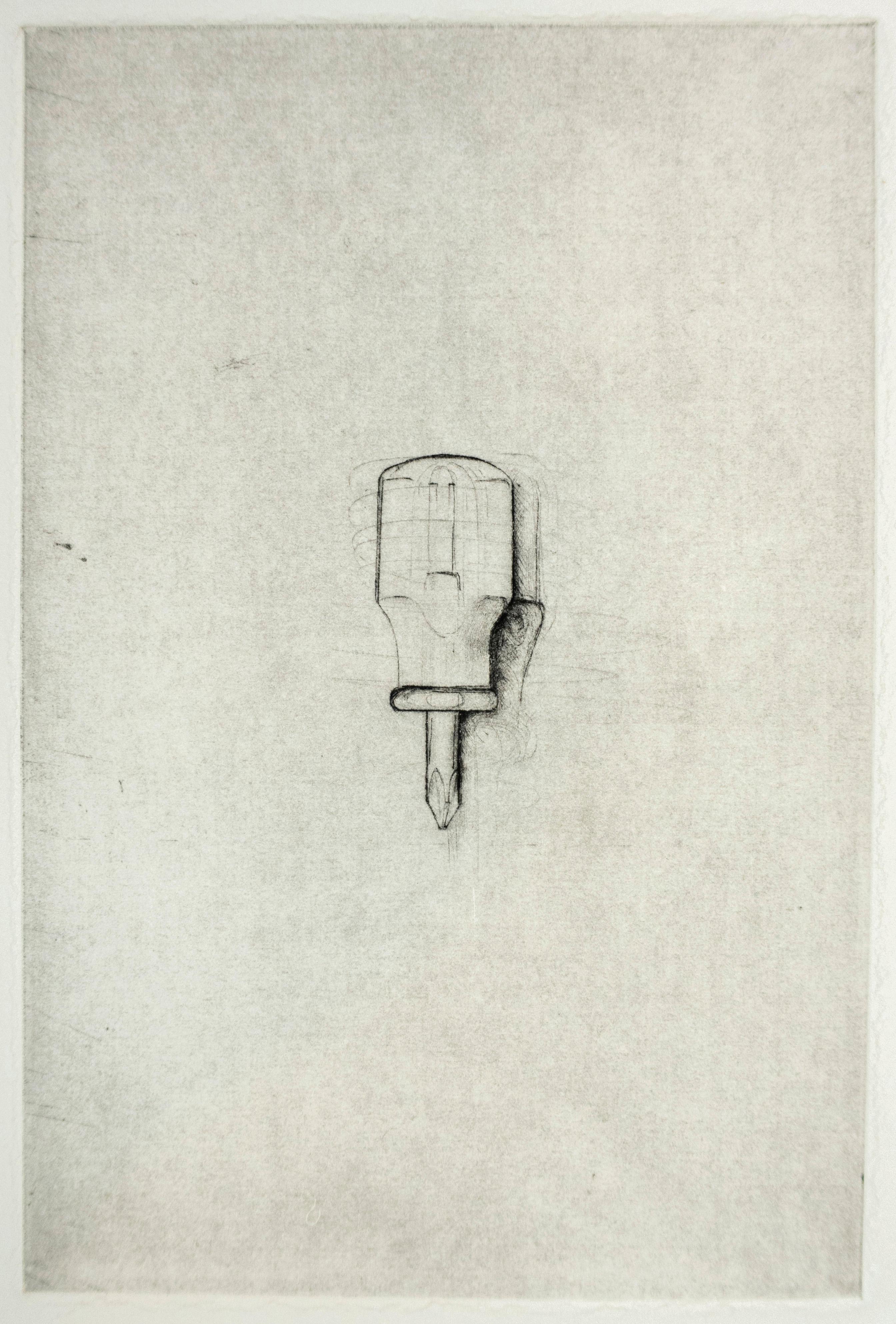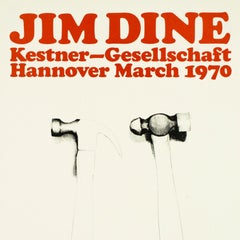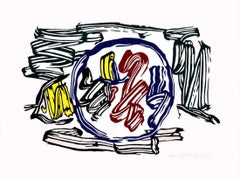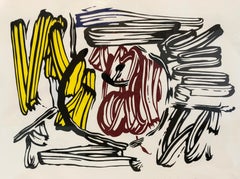
Red and Yellow Apple (from Seven Apple Woodcuts) by Roy Lichtenstein
View Similar Items
Roy LichtensteinRed and Yellow Apple (from Seven Apple Woodcuts) by Roy Lichtenstein 1982
1982
About the Item
- Creator:Roy Lichtenstein (1923 - 1997, American)
- Creation Year:1982
- Dimensions:Height: 28.75 in (73.03 cm)Width: 37.5 in (95.25 cm)
- Medium:
- Movement & Style:
- Period:
- Condition:Lower right corner bent. Some minor dents/spots in paper. Minor scratching throughout plexiglass with some deeper scratches.
- Gallery Location:New York, NY
- Reference Number:1stDibs: LU121129041762
Roy Lichtenstein
Roy Lichtenstein is one of the principal figures of the American Pop art movement, along with Andy Warhol, James Rosenquist, Claes Oldenburg and Robert Rauschenberg.
Drawing inspiration from comic strips, Lichtenstein appropriated techniques commercial printing in his paintings, introducing a vernacular sensibility to the visual landscape of contemporary art. He employed visual elements such as the halftone dots that comprise a printed image, and a comic-inspired use of primary colors gave his paintings their signature “Pop” palette.
Born and raised in New York City, Lichtenstein enjoyed Manhattan’s myriad cultural offerings and comic books in equal measure. He began painting seriously as a teenager, studying watercolor painting at the Parsons School of Design in the late 1930s, and later at the Art Students League, where he worked with American realist painter Reginald Marsh. He began his undergraduate education at Ohio State University in 1940, and after a three-year stint in the United States Army during World War II, he completed his bachelor’s degree and then his master’s in fine arts. The roots of Lichtenstein’s interest in the convergence of high art and popular culture are evident even in his early years in Cleveland, where in the late 1940s, he taught at Ohio State, designed window displays for a department store and painted his own pieces.
Working at the height of the Abstract Expressionist movement in the 1950s, Lichtenstein deliberately eschewed the sort of painting that was held in high esteem by the art world and chose instead to explore the visual world of print advertising and comics. This gesture of recontextualizing a lowbrow image by importing it into a fine-art context would become a trademark of Lichtenstein’s artistic style, as well as a vehicle for his critique of the concept of good taste. His 1963 painting Whaam! confronts the viewer with an impact scene from a 1962-era issue of DC Comics’ All American Men of War. Isolated from its larger context, this image combines the playful lettering and brightly colored illustration of the original comic with a darker message about military conflict at the height of the Cold War. Crying Girl from the same year featured another of Lichtenstein’s motifs — a woman in distress, depicted with a mixture of drama and deadpan humor. His work gained a wider audience by creating a comic-inspired mural for the New York State Pavilion of the 1964 World's Fair, he went on to be represented by legendary New York gallerist Leo Castelli for 30 years.
In the 1970s and ’80s, Lichtenstein experimented with abstraction and began exploring basic elements of painting, as in this 1989 work Brushstroke Contest. In addition to paintings in which the brushstroke itself became the central subject, in 1984 he created a large-scale sculpture called Brushstrokes in Flight for the Port Columbus International Airport in Ohio. Still Life with Windmill from 1974 and the triptych Cow Going Abstract from 1982 both demonstrate a break from his earlier works where the subjects were derived from existing imagery. Here, Lichtenstein paints subjects more in line with the norms of art history — a pastoral scene and a still life — but he has translated their compositions into his signature graphic style, in which visual elements of printed comics are still a defining feature.
Lichtenstein’s work is represented in the collections of the Metropolitan Museum of Art, the Museum of Modern Art, Tate Modern, and many others. He was awarded National Medal of Arts in 1995, two years before he passed away.
Find a collection of Roy Lichtenstein prints, drawings and more on 1stDibs.
- Flower Garden (color trial proof) James Rosenquist Pop Art in black and whiteBy James RosenquistLocated in New York, NYBased on Rosenquist’s 1961 grisaille oil painting Flower Garden, this work arranges a still life using an advertisement for gloves with part of an athlete’s torso. A number 1 can be ...Category
1970s Pop Art Figurative Prints
MaterialsLithograph, Screen
- Phillips Screwdriver (Jim Dine 30 Bones of My Body portfolio) tool dry pointBy Jim DineLocated in New York, NYThe hand tool is undoubtedly Jim Dine’s most iconic motif. Meticulously catalogued in rows like scientific specimens or sketched individually, hammers, awls, brushes, saws and screwdrivers assume a visceral symbolism. Curvilinear handles evoke the contours of limbs or bones, and even metal points and blades seem organic under Dine’s thoughtful hand. In this series of dry point prints...Category
1970s Pop Art Figurative Prints
MaterialsDrypoint
- Vintage Jim Dine tool Poster Kestner Gesellschaft 1970 (Hammers 1970) retro redBy Jim DineLocated in New York, NYThis vintage exhibition poster reproduces Jim Dine’s 1970 lithograph Hammers, which is in the collection of the Museum of Contemporary Art, Chicago. It w...Category
1970s Pop Art Still-life Prints
MaterialsLithograph
- Ice Cream Desserts (A) Claes Oldenburg dessert parfait etching in rainbow pastelBy Claes OldenburgLocated in New York, NYThe painterly, multicolored effect of this pastel ice cream still life is achieved by printing “à la poupée”, in which multiple colors can be applied to the plate for printing at one time. Oldenburg first printed in brown, and for the second plate, freely applied yellow, green, purple, blue, and light purple, producing an array of loosely sketched pastel confections. Image 13.5 x 21.15 in. / 34.3 x 53.7 cm Paper 22.5 x 31.25 in. / 57 x 79.4 cm Soft-ground etching and aquatint in six colors “à la poupée” on cream, thick, slightly textured Arches paper. Signed by the artist with initials lower center in pencil, dated 1976 lower right in pencil, and annotated AP VIII/XII lower left in pencil. Ice cream is a subject Claes Oldenburg has returned to again and again: from monumental sculptures of ice cream cones, to plaster parfaits, to countless drawings and designs. On his soft sculptures, Oldenburg wrote: "Reversing the expectations of hard sculpture, these huge collapsing objects rely on gravity and chance for their final form." The drooping edges of his soft sculptures connect to the unpredictably melting surface of ice cream, which he has explored viscerally through his dripped plaster ice cream sculptures...Category
1970s Pop Art Figurative Prints
MaterialsEtching
- Hole Punch (Jim Dine 30 Bones of My Body portfolio) tool dry pointBy Jim DineLocated in New York, NYThe hand tool is undoubtedly Jim Dine’s most iconic motif. Meticulously catalogued in rows like scientific specimens or sketched individually, hammers, awls, brushes, saws and screwd...Category
1970s Pop Art Figurative Prints
MaterialsDrypoint
- Tool Drypoint: Wrench by Jim Dine, black and white tool still life sketchBy Jim DineLocated in New York, NYJim Dine drew the plate for this image in the same period as his “Thirty Bones of My Body” 1972 portfolio of drypoint tool images. Crisbrook paper (30 x 22 in. / 76.2 x 56 cm.) and p...Category
1970s Modern Figurative Prints
MaterialsDrypoint
- Apple and LemonBy Roy LichtensteinLocated in Palo Alto, CARoy Lichtenstein Apple and Lemon, 1983 is an excellent example of the artist’s later work. Lichtenstein largely abandoned his famous comic strip pan...Category
1980s Pop Art Still-life Prints
MaterialsHandmade Paper, Woodcut
Price Upon Request - Pajaro (Green Lamp), Pop Art Serigraph by John GrilloBy John GrilloLocated in Long Island City, NYArtist: John Grillo, American (1917 - 2014) Title: Kaleidoscope I Year: 1978 Medium: Serigraph, signed and numbered in pencil Edition: 200, AP 30 Image Size: 29.5 x 22 inches ...Category
1980s Pop Art Figurative Prints
MaterialsScreen
- Kaleidoscope III, Pop Art Serigraph by John GrilloBy John GrilloLocated in Long Island City, NYArtist: John Grillo, American (1917 - 2014) Title: Kaleidoscope III Year: 1980 Medium: Serigraph, signed and numbered in pencil Edition: 200 Image Size: 22 x 30 inches Size: 2...Category
1980s Pop Art Figurative Prints
MaterialsScreen
- Eye of the Storm, Screenprint by Michael KniginBy Michael KniginLocated in Long Island City, NYArtist: Michael Knigin, American (1942 - 2011) Title: Eye of the Storm Year: 1971 Medium: Screenprint, signed and numbered in pencil Edition: 136/200 ...Category
1970s Pop Art Still-life Prints
MaterialsScreen
$520 Sale Price20% Off - Large Donald Saff Surrealist Pop Art Aquatint Etching Bee, Chair, PotBy Donald SaffLocated in Surfside, FLArtist: Donald Saff Medium: Etching with Aquatint, Hand signed and numbered in pencil Donald Jay Saff (born 12 December 1937) is an artist, art historian, educator, and lecturer, specializing in the fields of contemporary art in addition to American and English horology. Saff was born in Brooklyn, New York. Donald Saff began his undergraduate degree at Queens College, City University of New York, in 1955, initially envisioning a career as an electrical engineer. However, the following year Saff changed his major to art and learned printmaking, to graduate with a B.A. in 1959 and a M.A. in art history from Columbia University in 1960. In the years following, Saff was awarded a M.F.A. from Pratt Institute in 1962 and an Ed.D. in studio art and art history from Columbia University in 1964. In his early career, Saff studied with Robert Goldwater, Robert Branner, Louis Hechenbleikner, and Meyer Schapiro. Saff is primarily known for his work and collaboration with the leading artists of the late-twentieth century, including Robert Rauschenberg, Jim Dine, Roy Lichtenstein, James Rosenquist, Nancy Graves, Philip Pearlstein, and James Turrell. Saff's prolific career is the subject of Marilyn S. Kushner's book, Donald Saff: Art in Collaboration (2010). Saff began his teaching career at Queens College as a lecturer in Art History, Design, and Drawing, from 1961 to 1964. In 1965, Saff was appointed as an associate professor in the visual arts department of the University of South Florida in Tampa, Florida, and became professor and chairman of the visual arts department two years later. In 1971, Saff became the founding dean of the College of Fine Arts at U.S.F., and was awarded the rank of distinguished professor at the university in 1982. Saff was later named dean emeritus by USF in 1989, and distinguished professor emeritus in 1996. In 1999, Saff was awarded the honorary degree of Doctor of Fine Arts at U.S.F. He was appointed the Director of Capital Projects of the Solomon R. Guggenheim Foundation, New York, in 2001, followed by the appointment of Senior Curator of Prints and Drawings in 2002. In 1968, Saff founded Graphicstudio at U.S.F. through funding by a seed grant from the Florida Arts Council and community supporters; the following year, Philip Pearlstein was the first artist invited to Graphicstudio to collaborate with Saff and his team. Saff became Founding Dean of the College of Fine Arts at U.S.F. in 1971. Under Saff's directorship, Graphicstudio collaborated with artists such as James Rosenquist, Robert Rauschenberg, Richard Anuszkiewicz, Shusaku Arakawa, Jim Dine, Lee Friedlander, Nancy Graves, Ed Ruscha, and Roy Lichtenstein. The collection of Graphicstudio is archived in the National Gallery of Art in Washington, D.C. Graphicstudio was founded by Dr. Donald Saff as part of the renaissance in American printmaking in the 1960s, in the company of studios such as ULAE, Tamarind, and Gemini GEL. This renaissance brought artists involved in the Pop art movement, such as Robert Rauschenberg, James Rosenquist, and Jim Dine, together with a growing number of trained printmakers from around the world. After Saff retired from U.S.F., he continued to collaborate with these artists, as well as James Turrell, at Saff Tech Arts in Oxford, Maryland, which was established in 1991. While Saff and Rauschenberg were traveling in China, Rauschenberg conceived of the Rauschenberg Overseas Culture Interchange (ROCI) in 1982, which began in 1984 with Saff as the artistic director. Saff travelled to over twenty countries and met with poets and writers in order to decide which were the most appropriate venues for the show and prepare for Rauschenberg's visit and exhibition. In recent years, Saff has continued to lecture and write on art and the history and mechanics of nineteenth-century clocks; in particular, the work of Charles Fasoldt, in addition to the development of time distribution from the Harvard College Observatory, and the horological innovations of Richard F. Bond. He has lectured on Fasoldt for the Antiquarian Horological Association in Cincinnati, OH (2001), the National Association of Watch and Clock Collectors in Pittsburgh, PA, and Anheim, CA (2003), and at the 26th Annual Ward Francillon Time Symposium in Houston, TX (2004), among other venues. Saff continues to work with the Royal Observatory in Greenwich, collaborating with Jonathan Betts and Rory McEvoy, on the trials of Burgess Clock B. (See "Honors.") Exhibitions Saff's individual work spans across his career of collaborative art. As early as 1965, Saff produced Duino Elegies, a print suite that was published and exhibited by Martin Gordon Gallery in New York and at the Galleria Academia in Rome; it was acquired by the Library of Congress, the Brooklyn Museum, and Lessing Rosenwald. Saff also collaborated with printers Galli and Arduini in Urbino to create print suites Breezes (1969), exhibited and published by the Martin Gordon Gallery. Additionally, Saff collaborated with Galli on print suites Paradise Lost (1970) and Numbers (1972), the former printed in Tampa, FL, and exhibited at the Martin Gordon Gallery, the University of South Florida Gallery, the Toronto Art Gallery, and the Loch Haven Art Center, FL. Numbers was exhibited at Multiples Gallery, New York. In 1979, Saff produced print suite Fables that was published and exhibited by the Getler/Pall Gallery in New York, followed by the print suite Constellations (1980), which was also exhibited at the Tom Lutrell Gallery in San Francisco. In 1981, Saff had solo exhibitions of his artwork in the Galleria d'Arte Moderna in Udine, Italy, Youngstown State University, OH, the Leo Castelli Gallery, NY, and in "Recent Acquisitions" at The Museum of Modern Art, NY. Additionally, Saff had solo exhibitions at Dyansen Gallery, NY (1982), at I. Feldman Gallery, Sarasota (1983), and at Edison Community College, FL (1988). In 1989, the retrospective Donald Saff: Mixed Metaphors, 1956–1989 was held at the Tampa Museum of Art and traveled to the Virginia Beach Center for the Arts, followed by his solo exhibition Winged Metaphors: Sculpture and Prints by Donald Saff at the Barbara Gillman Gallery in Miami later that year. In 1997, Brenau University Galleries exhibits Poetics: The Work of Donald Saff in Gainesville, GA. The same year, the Tampa Museum of Art exhibited Donald Saff/Robert Rauschenberg: In Collaboration. Finally, the Academy Art Museum in Easton, MD, exhibited Donald Saff: Gravity and Constellations; Selected Works in 2006. Honors Saff was awarded a Teaching Fellowship at Queens College (1960), a Yaddo Fellowship, Saratoga Springs, NY (1963), and Fulbright Fellowship (1964) to Italy where he studied at Istituto Statale di Belle Arti. While in Urbino, Saff met lifelong friend and colleague Deli Sacilotto, with whom he would co-author Printmaking: History and Process (1978) and Screenprinting: History and Process (1979). He received the Governor's Award for the Arts from the State of Florida in 1973, and was awarded the Florida Endowment for the Arts Individual Artist Grant in 1980. In 1997, Saff was awarded the title "Printmaker Emeritus" by the 25th Southern Graphics Council Conference in Tampa, F.L. In 2002, he was appointed as Visiting Distinguished Professor of Rhode Island School of Design. In April 2015, Saff was awarded a certificate from the Guinness World Records for his work on completing the world's most accurate pendulum clock, "Clock B", which was started by Martin Burgess in 1975. The official title awarded by Guinness World Records, as "the most accurate mechanical clock with a pendulum...Category
1980s Pop Art Figurative Prints
MaterialsEtching, Aquatint
- R.B. Kitaj Screenprint Collage Hand Signed British Pop Art Film Still CamelBy Ronald Brooks KitajLocated in Surfside, FLThe Most Important Film Ever Made, 1972 Color screen print and collage, from the edition of 70. 15 x 17 in 38.1 x 43.2 cm Published by the artist with Marlborough Graphics at the Kelpra studio in 1972. This work is also in the collections of TATE London and the Victoria & Albert Museum. the price reflects the fact that there is no backing page. Stylistically, these are hybrid works, influenced by Pop art and the modernist tradition of the Readymade, a work of art created when a mundane found object is named as an artwork and set in an art context. This avant-garde concept was originally invented by the Dada master Marcel Duchamp early in the twentieth century. In the 1960s it received renewed attention at a time when artistic norms were again being questioned. Reacting to Andy Warhol’s Pop imagery, Kitaj poignantly called his repurposed lithograph and silkscreen book covers “his soup can, his Liz Taylor.” The blatant use of images taken directly from commercial sources situates In Our Time as a precursor of appropriation art. In turning book covers into works of art, Kitaj is offering fragments of a history of knowledge, in which the content of each volume is at once mysterious and absent. Coming from this passionate bibliophile, the series is nothing less than an intellectual self-portrait. R.B. Kitaj, in full Ronald Brooks Kitaj . Ron Kitaj...Category
1960s Pop Art Still-life Prints
MaterialsScreen
